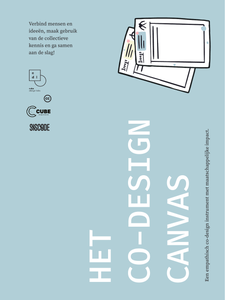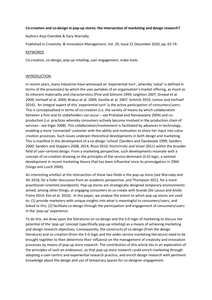Although empathy is an essential aspect of co-design, the design community lacks a systematic overview of the key dimensions and elements that foster empathy in design. This paper introduces an empathic formation compass, based on a comparison of existing relevant frameworks. Empathic formation is defined here as the formative process of becoming an empathic design professional who knows which attitude, skills and knowledge are applicable in a co-design process. The empathic formation compass provides designers with a vocabulary that helps them understand what kind of key dimensions and elements influence empathic formation in co-design and how that informs designers’ role and design decisions. In addition, the empathic formation compass aims to support reflection and to evaluate co-design projects beyond the mere reliance on methods. In this way, empathic design can be made into a conscious activity in which designers regulate and include their own feelings and experiences (first-person perspective), and decrease empathic bias. We identify four important intersecting dimensions that empathy is comprised of in design and describe their dynamic relations. The first two opposing dimensions are denoted by empathy and differentiate between cognitive design processes and affective design experiences, and between self-and other orientation. The other two dimensions are defined by design research and differentiate between an expert and a participatory mindset, and research-and design-led techniques. The empathic formation compass strengthens and enriches our earlier work on mixed perspectives with these specific dimensions and describes the factors that foster empathy in design from a more contextual position. We expect the empathic formation compass—combined with the mixed perspectives framework—to enhance future research by bringing about a deeper understanding of designers’ empathic and collaborative design practice.
DOCUMENT

The numerous grand challenges around us demand new approaches to build alternative sustainable futures collectively. Whereas these so-called co-design processes are becoming more mainstream, many multi-stakeholder coalitions lack practical guidance in these dynamic and systemic challenges based on entangled relationships, interactions, and experiences between stakeholders and their environments. Although scholars and practitioners convey a lot of co-design theories and methods, there does not seem to be a practical instrument beyond methods that supports new coalitions with an overview of a co-design process to come and in making shared and fundamental co-design decisions. Therefore, this paper proposes the empathic Co-Design Canvas as a new intermediate-level knowledge product existing of eight co-design decision cards, which together make up the Canvas as a whole. The Canvas is based on an existing theoretical framework defined by Lee et al. (2018), an empirical case study, and a diversity of experiences in education and practice. It aims at supporting multi-stakeholder coalitions to flexibly plan, conduct, and evaluate a co-design process. Moreover, the Canvas encourages coalitions to not only discuss the problematic context, a common purpose, envisioned impact, concrete results, and each other’s interests and knowledge, but also power, which can create trust, a more equal level playing field and empathy, and help manage expectations, which is greatly needed to overcome today’s grand challenges.
LINK
Designers are increasingly collaborating with various stakeholders to address complex societal challenges. These challenges often require a codesign approach, where differ-ent actors with diverse perspectives and experiences unite to explore innovative ave-nues for change. Such collaboration requires empathy between the actors to under-stand each other’s perspective better in their interactions. This paper aims to assist so-cial designers in orchestrating such empathic codesign processes by introducing an Em-pathic Journey framework. This conceptual and practical framework is based on em-pathic design theory and three design cases which used Virtual Reality for perspective exchange between actors. The framework addresses the importance of integrating an emotional spark through immersion and the necessity of embedding immersive experiences in a larger journey.
MULTIFILE

Van de flaptekst: Service design - het ontwerpen van dienstverlening verbetert bestaande diensten of ontwerpen geheel nieuwe. Daarbij wordt gekozen voor een andere invalshoek: creatief onderzoekend en gericht op de ervaringen van individuele gebruikers. Dit is een eindpublicatie van het prgramma Innoveren in Dienstverlening. In negen verschillende projecten werden door creatieve bureaus methoden van service design toegepast. Van dit boek is ook een Engelstalige versie beschikbaar.
DOCUMENT

Higher education, as a catalyst for social progress and talent development, holds a unique position to foster mutual learning across sectors, disciplines, life-spheres and communities. By nurturing critical thinking and creativity, education can empower students to drive and take societal and environmental responsibility. Empathic co-design emerges as a crucial approach for navigating complexity and establishing change. Exposure to diverse perspectives encourages individuals, particularly students, to expand their empathy by challenging their preconceptions, fostering understanding, and promoting a deeper sense of interconnectedness with others. Recognizing the significance of empathy in educational co-design contexts and beyond, this paper introduces the Empathy Compass. Through two case studies on the societal impact of Ecstasy production and use, we demonstrate the Compass's utility in tracking students’ empathic awareness. The practice-oriented, three-dimensional tool highlights specific mindsets, activities and methodologies within each quadrant, its intersections and the ‘we-space’. The Empathy Compass emerges as a valuable tool for higher education, supporting the stimulation, facilitation and assessment of empathic awareness in multi-stakeholder collaboration. Om het arikel te kunnen lezen moet het aangekocht worden: https://www.tandfonline.com/eprint/ZT7WHUWNC5C3CTTZ7REH/full?target=10.1080/07294360.2025.2510670#abstract
DOCUMENT
Eindpublicatie van het programma Innoveren in Dienstverlening. In negen verschillende projecten werden door creatieve bureau's methoden van service design toegepast. De verschillende projecten zijn uitgevoerd met dienstverleners rondom Utrecht CS, het UMC Utrecht en de Hogeschool Utrecht
DOCUMENT

Our society faces many challenges, necessitating collaborative efforts among multiple stakeholders. Our students learn this in living labs. This paper explores preliminary research on introducing co-design to novices. We introduce a case study exploring how design educators can support students in developing co-design competencies. Central to this study is our Co-Design Canvas, introduced as a pivotal tool for fostering open dialogue among diverse stakeholders. This stimulates collaboration through effective teamwork and empathic formation. The research questions aim to discover effective methods for introducing the Co-Design Canvas to living lab students, and to identify the necessary prior knowledge and expertise for both novices and educators to effectively engage with and teach the Co-Design Canvas. The paper advocates for a pedagogical shift to effectively engage students in multi-stakeholder challenges. Through a series of workshops, the Co-Design Canvas was introduced to novices. We found that this required a significant cognitive stretch for staff and students. The paper concludes by presenting a, for now, final workshop format consisting of assignments that supports introducing the Canvas and thereby co design to societal impact design novices. This program better prepares students and coaches for multi stakeholder challenges within living labs.
MULTIFILE

Het Co-Design Canvas is een instrument om samenwerkingen rondom maatschappelijke uitdagingen met verschillende betrokkenen open en transparant te starten, plannen, uitvoeren en evalueren. Het biedt een hulpmiddel aan overheden, burgers, bedrijven, non-profitorganisaties, kennisinstellingen en andere belanghebbenden om helder te kunnen communiceren en samenwerken. Het maakt verschillen in belangen, kennis, ervaring en machtsverhoudingen inzichtelijk, staat vanaf het begin stil bij gewenste positieve impact en concrete resultaten en zorgt ervoor dat ieders stem echt gehoord wordt.
MULTIFILE

A commonality in socially-aware persuasive games is the strategy to appeal to empathy, as a means to have players feel and understand the struggles of another. This is particularly evident in the expanding use of immersive technologies, lauded for its ability to have players more literally 'stand in another's shoes'. But despite the growing interest, empathic engagement through immersive technologies is still ill-defined and the design thereof complicated, with questions like "who is the player?" and "with whom does the player empathize?". We contend that a better understanding of the different perspectives to empathic engagement - the observer, partaker, and victim - and the gap between realities can be insightful, and resulted in a framework to support future research and design.
DOCUMENT
Co-creation as a concept and process has been prominent in both marketing and design research over the past ten years. Referring respectively to the active collaboration of firms with their stakeholders in value creation, or to the participation of design users in the design research process, there has arguably been little common discourse between these academic disciplines. This article seeks to redress this deficiency by connecting marketing and design research together—and particularly the concepts of co-creation and co-design—to advance theory and broaden the scope of applied research into the topic. It does this by elaborating the notion of the pop-up store as temporary place of consumer/user engagement, to build common ground for theory and experimentation in terms of allowing marketers insight into what is meaningful to consumers and in terms of facilitating co-design. The article describes two case studies, which outline how this can occur and concludes by proposing principles and an agenda for future marketing/design pop-up research. This is the peer reviewed version of the following article: Overdiek A. & Warnaby G. (2020), "Co-creation and co-design in pop-up stores: the intersection of marketing and design research?", Creativity & Innovation Management, Vol. 29, Issue S1, pp. 63-74, which has been published in final form at https://doi.org/10.1111/caim.12373. This article may be used for non-commercial purposes in accordance with Wiley Terms and Conditions for Use of Self-Archived Versions. LinkedIn: https://nl.linkedin.com/in/overdiek12345
MULTIFILE
